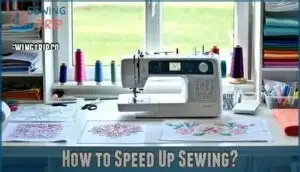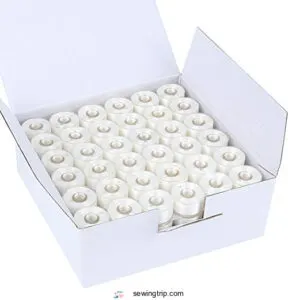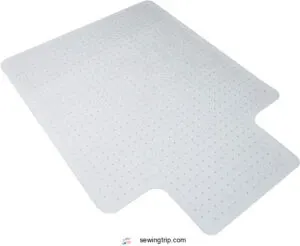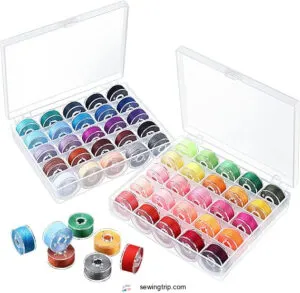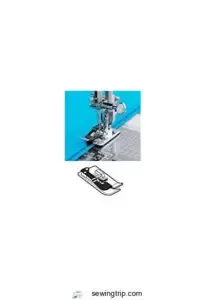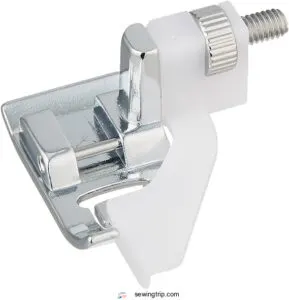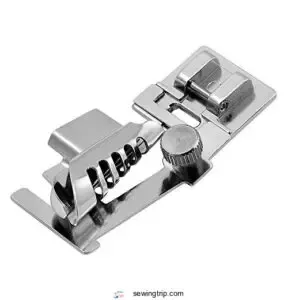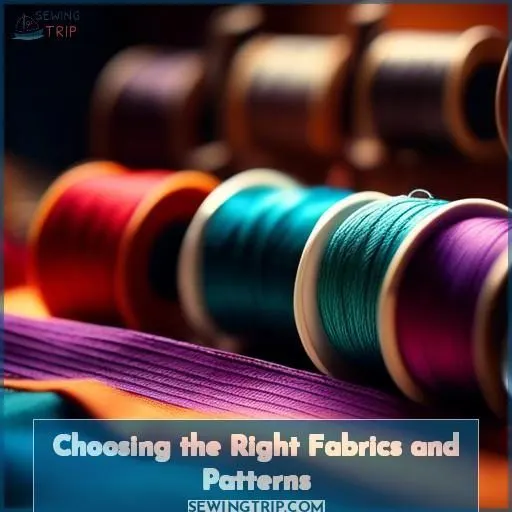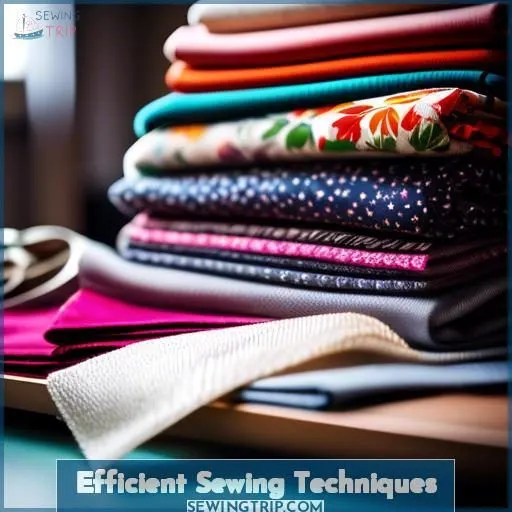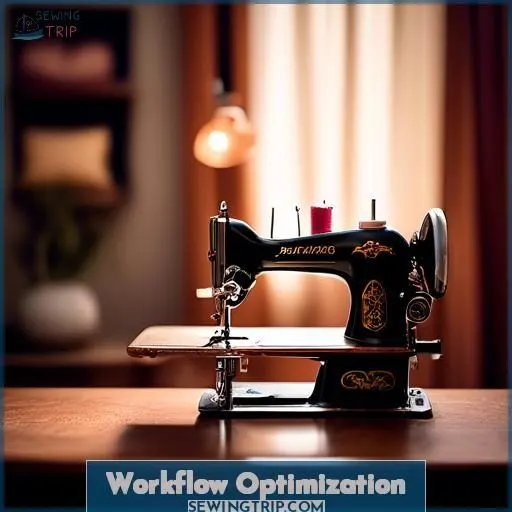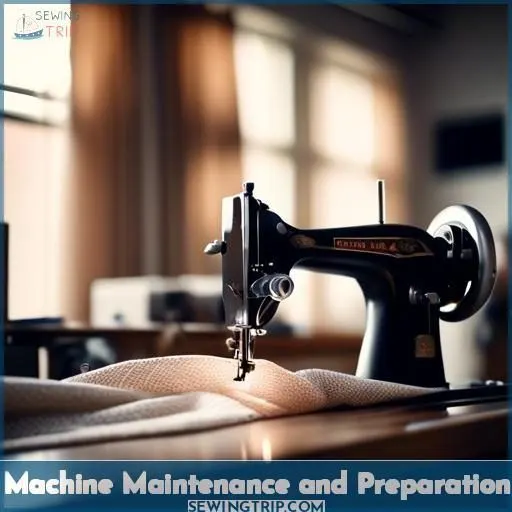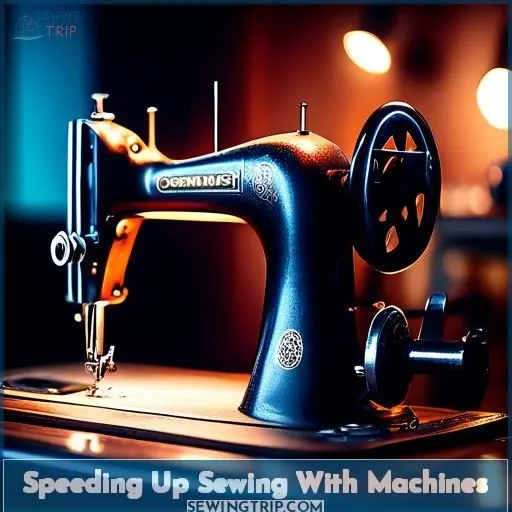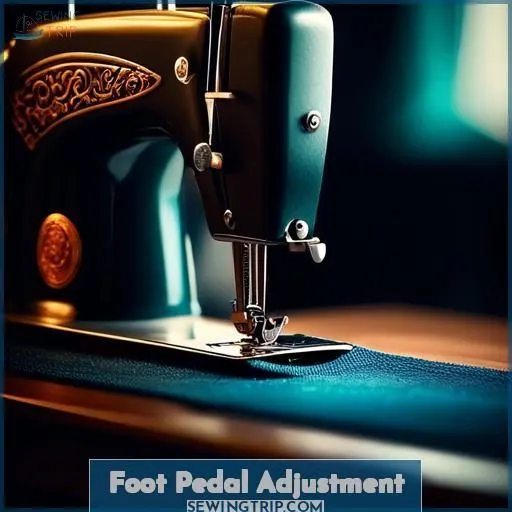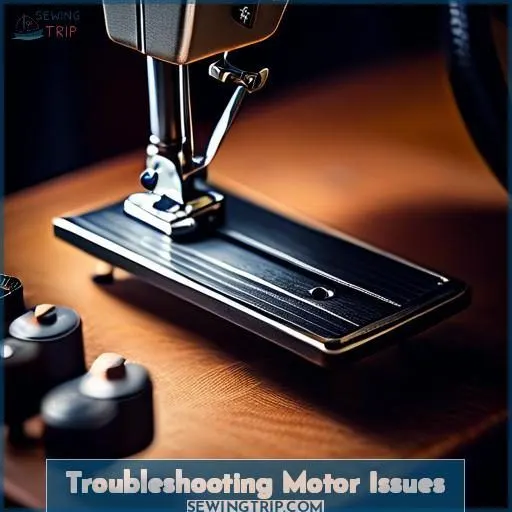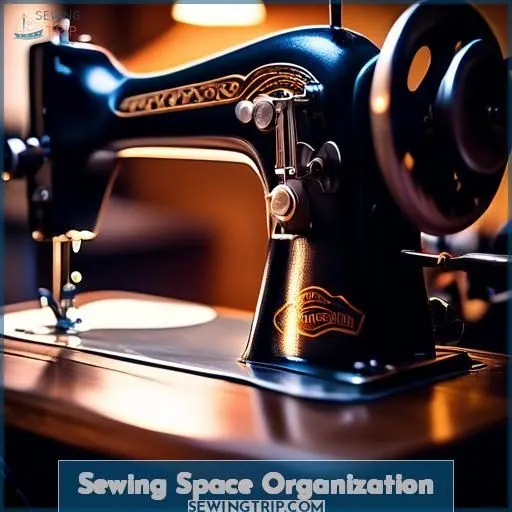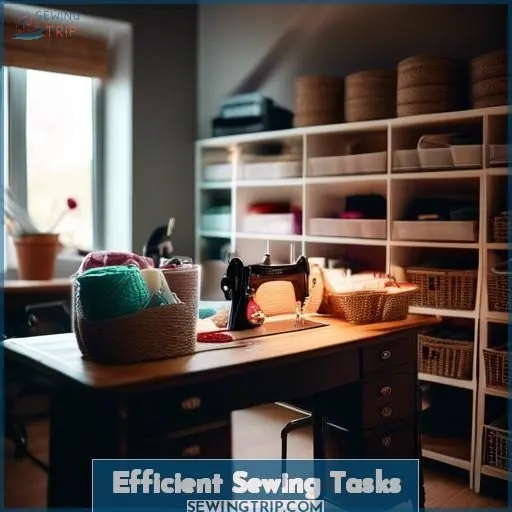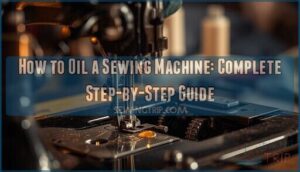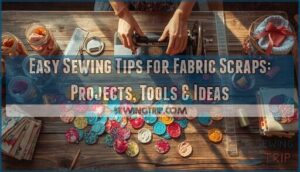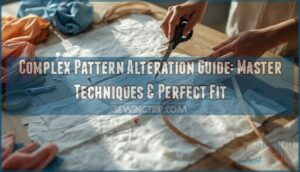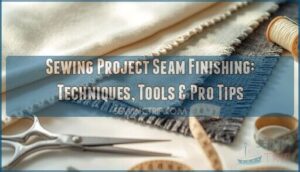This site is supported by our readers. We may earn a commission, at no cost to you, if you purchase through links.
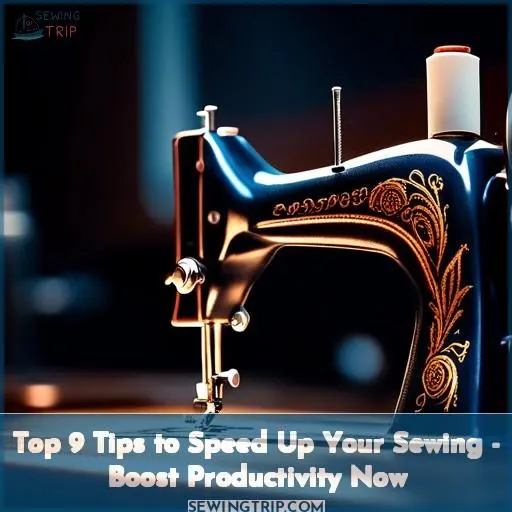
Choose uncomplicated fabrics and patterns to reduce cutting and assembly time. Sew without pinning or basting, utilize machine basting, and practice various stitches.
Cut fabric wrong-side-out, iron interfacing prior to cutting, and assign pattern assembly tasks. Preserve your sewing machine by creating buttonholes first and routinely lubricating it.
These time-saving strategies can markedly enhance your sewing productivity. Continue reading to uncover additional tips that will significantly augment your sewing speed.
Table Of Contents
- Key Takeaways
- How to Speed Up Sewing?
- Top 9 Tips for Speeding Up Sewing
- 1. Embroidery Pre-Wound Bobbins Thread Black
- 2. Amazon Basics Drafting Spa Bar Stool
- 3. Prewound Bobbin Thread for Embroidery Sewing
- 4. Snap On Blind Stitch Presser Foot
- 5. Ofm Carpet Computer Desk Chair Mat
- 6. Prewound Thread Bobbins for Brother Sewing Machine
- 7. Janome Blind Hem Sewing Machine Foot
- 8. Brother Blind Stitch Horizontal Foot
- 9. Binder Presser Foot Fits Low Shank Machines
- Choosing the Right Fabrics and Patterns
- Efficient Sewing Techniques
- Workflow Optimization
- Machine Maintenance and Preparation
- Speeding Up Sewing With Machines
- Foot Pedal Adjustment
- Troubleshooting Motor Issues
- Sewing Space Organization
- Efficient Sewing Tasks
- Frequently Asked Questions (FAQs)
- Conclusion
Key Takeaways
- Utilize specialized tools like pre-wound bobbins, adjustable stools, and snap-on blind stitch feet to streamline your sewing process.
- Choose fabrics and patterns that are simple, loose-fitting, and avoid complex details or patterns to reduce cutting and assembly time.
- Adopt efficient sewing techniques like sewing without pinning or basting, using machine basting, and practicing various stitches to boost productivity.
- Optimize your workspace, maintain your sewing machine, and adjust the foot pedal to maximize speed and minimize interruptions.
How to Speed Up Sewing?
To accelerate your sewing, consider the following suggestions:
- Utilize pattern weights to maintain your fabric’s position and prevent its displacement.
- Employ water-soluble thread during basting to economize time.
- Select meticulously digitized embroidery designs devoid of thread breakage or redundant stitches to maximize your machine embroidery’s velocity.
- Modify the stitch width on your machine to accommodate varying thread types and attributes, as heavier threads might necessitate reduced speeds.
- Streamline your computer’s configuration to guarantee your embroidery machine’s efficient operation, as a more rapid computer can markedly enhance performance.
- Discontinue the usage of pins to minimize body movement and augment sewing speed.
By applying these recommendations, you can amplify your sewing speed and productivity.
Top 9 Tips for Speeding Up Sewing
Ready to elevate your sewing efficiency? Uncover the top 9 strategies that will accelerate your sewing journey, from utilizing pre-loaded bobbins to streamlining your workspace. Let’s embark!
1. Embroidery Pre-Wound Bobbins Thread Black
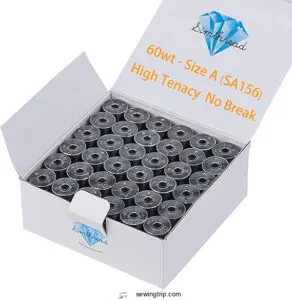
Pre-wound bobbins, such as the 144-piece pack of black pre-wound bobbins, are a convenient and time-saving option for embroidery and sewing projects. These bobbins are filled with 60 weight polyester thread, which is strong, durable, and resistant to shrinking and fading. They’re compatible with various commercial and home embroidery and sewing machines, including brands like Brother, Babylock, Janome, Juki, Elna, Quantum Futura, and Singer.
Using pre-wound bobbins can save you time and effort compared to winding bobbins yourself. They’re available in different colors, such as black, and are suitable for a wide range of embroidery machines. To achieve optimal results, it’s vital to select bobbins that are compatible with your machine and perform well in your specific project.
Pre-wound bobbins offer several advantages:
- Convenience: They’re ready to use, eliminating the need for manual winding and saving you time.
- Consistency: The thread is wound evenly, ensuring a consistent tension and quality of embroidery.
- Economy: Pre-wound bobbins can save you money in the long run, as they last longer than self-winding bobbins.
- Compatibility: They’re compatible with various embroidery machines, making them a versatile choice for different projects.
Best For: Embroidery and sewing enthusiasts seeking convenience and consistent results.
- Convenient and time-saving
- Evenly wound for consistent tension
- Durable and long-lasting
- May not be as economical as winding bobbins yourself
- Compatibility with specific machines should be checked
- May not be suitable for all embroidery projects
2. Amazon Basics Drafting Spa Bar Stool

When you’re knee-deep in fabric, the last thing you need is an achy back from a subpar seat. Enter the Amazon Basics Drafting Spa Bar Stool: your trusty sidekick in the battle against time-consuming sewing projects.
With its adjustable height, you can kiss those awkward hunching moments goodbye and sew at the perfect altitude. Plus, the 360-degree swivel means you’re as nimble as a cat, darting from sewing machine to cutting table without missing a beat.
And let’s not forget the smooth-rolling wheels—gliding over to snatch your scissors will feel like a breeze. So, park your behind on this comfy throne and watch your productivity soar!
Best For: Those seeking a comfortable and versatile seating option for home or workplace use.
- Adjustable seat height for optimal comfort
- 360-degree swivel for easy multitasking
- Dual-wheel casters for smooth maneuverability
- May not be suitable for heavy-duty use
- Bonded leather upholstery may not be as durable as genuine leather
- Assembly may be required
3. Prewound Bobbin Thread for Embroidery Sewing
Prewound bobbins are a game-changer for sewing enthusiasts seeking to expedite their workflow. These bobbins are pre-wound with premium thread, guaranteeing consistent tension and uniform distribution of thread throughout the bobbin. They’re available in various sizes and materials, such as L-style and M-style, and are suitable for most sewing machines. Prewound bobbins can accommodate up to 50-100% more thread than traditional self-wound bobbins, ultimately saving you time and effort.
Utilizing prewound bobbins can be a more convenient and efficient choice for sewists. They’re designed to function with a wide range of sewing machines, eliminating the necessity for compatibility charts when purchasing thread. Furthermore, prewound bobbins are manufactured to provide optimal stitching quality, ensuring smooth thread delivery and minimal lint accumulation.
When using prewound bobbins, it’s imperative to verify their compatibility with your specific sewing machine model. Certain manufacturers may not advise using pre-wound bobbins, while others may offer their own line of pre-wound bobbins and actively promote their use. Always consult with your machine’s manufacturer or refer to the user manual for specific guidance.
Best For: Sewing enthusiasts seeking to expedite their workflow and ensure consistent tension.
- Consistent tension and uniform thread distribution
- Time and effort savings compared to self-winding bobbins
- Fits most sewing machines, eliminating compatibility concerns
- Some bobbins may have unevenly distributed thread, leading to false low-bobbin warnings
- Not compatible with all sewing machine models
- Can be more expensive than self-wound bobbins
4. Snap On Blind Stitch Presser Foot
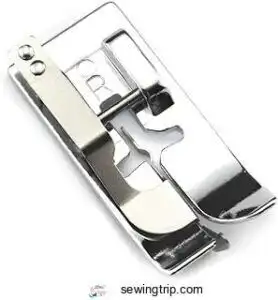 View On Amazon
View On Amazon
Snap on blind stitch presser feet are a game-changer for your sewing machine. They allow you to change presser feet without the need to unscrew and screw in a new foot, saving you time and frustration. To use a snap on blind stitch presser foot, follow these steps:
- Attach the blind hem foot on your sewing machine. It’s a snap-on foot for most home sewing machines.
- Use the same color thread as the fabric on the top thread spool and bobbin to make truly invisible stitches.
- Mark the hem line on the backside of the fabric with a marking tool, then fold the fabric so that the marked hem is at the center of the fold, leaving a 1/4 inch extra at the finished edge.
- Press the folded edge to prevent it from shifting as you sew.
- Adjust the stitch type to the blind hem stitch, which is a combination of straight stitches and a zig-zag stitch.
- Align the edge guide on the foot with the fold of the fabric.
- Adjust the needle position to the left, keeping it in line with the edge guide of the foot.
- Adjust the stitch length and width to your preference.
Best For: Sewists who want to save time and sew invisible hems with ease.
- Snap-on design allows for quick and easy foot changes.
- Produces professional-looking blind hems.
- Adjustable edge guide ensures precise stitch placement.
- May not be compatible with all sewing machines.
- Can be tricky to adjust the needle position correctly.
- Requires practice to achieve consistent results.
5. Ofm Carpet Computer Desk Chair Mat
To boost your sewing productivity, consider investing in a high-quality chair mat like the OFM Carpet Computer Desk Chair Mat. This mat is designed to protect your carpets from stains, dirt, casters, and heels, ensuring your floors last longer. With its molded cleats and studs, the mat holds the chair securely in place, preventing any damage to your carpet.
One of the key benefits of this mat is its anti-skid surface, which maintains a stable foundation for your chair, allowing for easy movement and preventing any unwanted slipping. The mat is also equipped with sloped edges for a smooth passage from floor to mat, making it easy to roll your chair on and off the mat.
To get the most out of your OFM Carpet Computer Desk Chair Mat, make sure to follow the manufacturer’s instructions for uncurling and flattening the mat. It may take up to 72 hours for the mat to fully uncurl, and you may need to set heavy objects around the edge to help flatten it.
Best For: Protecting low-pile carpets from dirt, stains, and damage caused by chair casters and heels.
- Molded cleats and studs for secure chair placement
- Anti-skid surface prevents slipping
- Sloped edges for easy chair movement
- May take up to 72 hours to uncurl and flatten
- Requires heavy objects to flatten
- Not intended for hard floors
6. Prewound Thread Bobbins for Brother Sewing Machine
Prewound thread bobbins for Brother sewing machines can dramatically accelerate your sewing process. These bobbins hold 50-100% more thread than a bobbin wound on a home sewing machine, enabling you to sew for extended periods without disruption.
They’re particularly advantageous for larger bobbin styles, like the Style 41, where winding can be more laborious and susceptible to mistakes. Prewound bobbins are also more user-friendly, as they remove the necessity of winding your own bobbins and can be effortlessly switched out when necessary.
Furthermore, prewound bobbins can facilitate improved tension and stitch quality, resulting in enhanced overall embroidery outcomes.
Best For: Individuals seeking to enhance their sewing efficiency and precision, particularly those using Brother sewing machines.
- Significantly reduces sewing interruptions due to extended thread capacity.
- Enhanced convenience with effortless bobbin replacement.
- Improved tension and stitch quality for superior embroidery results.
- May require additional effort to locate thread ends on some bobbins.
- Bobbins may break if dropped.
- Limited availability of certain colors or thread types.
7. Janome Blind Hem Sewing Machine Foot
Mastering the art of blind hemming is like finding the secret passage in a maze – it’s a game-changer. This little gem is designed to snugly fit against the fold of your fabric, ensuring accuracy while its grooves prevent any slip-ups. It’s like having a co-pilot, guiding your needle to create almost invisible stitches.
Enter the Janome Blind Hem Sewing Machine Foot, your trusty guide through this labyrinth. Compatible with a wide range of Janome models, it’s not just a foot; it’s your ticket to elevating your sewing game.
So, buckle up and let this foot take the wheel, making blind hemming a breeze and not a chore.
Best For: Sewers looking to improve their blind hemming technique.
- Helps improve blind hemming technique
- Metal guide and grooves prevent slipping
- Needle swings over guide to create slack in upper tension
- Not compatible with Janome Memory Craft 9900
- May not fit all Janome models
- Quality may vary
8. Brother Blind Stitch Horizontal Foot
The Brother Blind Stitch Foot – Horizontal (F017N) is a versatile accessory that can create blind hems on a variety of fabrics. It’s compatible with machines from groups A, B, C, D, E, F, J, K, M, and N. This foot is perfect for edge stitching**, attaching lace, and fabric edge joining.
To use it, you need to fold the raw edge of your fabric up one centimeter, press it into place, and then fold the new edge up two centimeters. Finally, flip the fabric to the inside, peel back the edge to expose the previous folded piece, and press the folded pieces in place before sewing.
Remember to align the raised inner folded edge to the left side of the guide within the foot and sew with the fabric sitting firmly against the guide to prevent missed stitches.
Best For: Seamstresses and crafters seeking a versatile foot for precise blind hems.
- Versatile for edge stitching, lace, and fabric edge joining
- Adjustable sole plate and seam guide for precise sewing
- Genuine Brother accessory for compatibility with all 7mm feed dog machines
- Useless instruction manual
- Requires some trial and error to master
- Potential for breakage during use
9. Binder Presser Foot Fits Low Shank Machines
Binder presser feet are designed to make sewing binding tape easy. They fold and feed the bias tape into the machine, allowing you to sew along the edge of the fabric with ease. These feet are particularly useful for sewing curves and corners, and they can be used with both zigzag and decorative stitches, as well as straight stitch.
Binder presser feet are compatible with low shank sewing machines, making them a versatile addition to your sewing toolkit. They’re available in various sizes, with the most common width for double-fold bias being ½ inch (12mm). Some binder feet also have adjustable screws to position the needle left or right for more precise sewing.
To use a binder foot, you first insert the binding into the slot in the plastic section of the foot. Then, attach the foot to your sewing machine and sew along the edge of the binding, making sure to sew with the shorter side of the bias tape on top.
Binder feet are a must-have tool for anyone who regularly sews bias tape or does quilting. They can save you hours of work on binding projects and guarantee professional-looking results.
Best For: Sewists who regularly sew bias tape or quilt.
- Ease-of-use
- Versatile
- Compatible with all low shank snap-on sewing machines
- Not suitable for very thick quilts and other thicker projects
- Can be difficult to set up initially
- Requires precise sewing
Choosing the Right Fabrics and Patterns
Want to sew faster? Focus on choosing the right fabrics and patterns. Avoid difficult materials, complex patterns, and opt for simple, loose-fitting designs that allow you to create multiple items from the same fabric.
Avoid Difficult Materials
To speed up your sewing, avoid difficult materials that can slow down your progress. Focus on fabrics with good material characteristics**, such as a smooth texture and simple pattern. Choose fabrics with a consistent weight and bias stability for easier handling.
When working with your sewing machine, consider the fabric’s compatibility with your presser foot. By selecting the right fabric, you’ll streamline your sewing process and boost productivity.
Avoid Fabrics With Patterns
Essential for fabric selection is avoiding fabrics with patterns. These can complicate visual perception and reduce your sewing pace. Instead, choose plain fabrics for easier manipulation. This will streamline your sewing process and conserve time. The objective is to optimize your sewing experience for both efficiency and ease. Therefore, when selecting your fabric, maintain simplicity and avoid patterns.
Choose Simple Patterns
After avoiding intricate patterns, it’s time to adopt pattern simplicity. Choosing beginner patterns not only accelerates your project but also guarantees a quick fit without complications.
- Select patterns with fewer pieces to reduce confusion and construction time.
- Utilize proven patterns that guarantee success.
- Eliminate details that are time-consuming, focusing exclusively on the pleasure of creation.
Choose Loose-Fitting Designs
Choose loose-fitting designs for your sewing projects to speed up your workflow. Opt for simple pattern designs that minimize the need for cutting and seam allowances. Avoid patterned fabrics, which can add complexity and require more time. Use flat construction methods and minimize thread changes by using gray thread for inside seams and chain stitch for faster sewing.
Make Several Items From the Same Fabric
Make several items from the same fabric to boost your sewing efficiency. This tip is all about fabric efficiency and minimizing waste. When you have a large fabric, cut multiples at the same time. If you’re working with several pieces of the same fabric, cut them all at once. This way, you’ll be able to use your fabric more effectively and avoid the hassle of cutting and re-cutting the same fabric multiple times.
When cutting, use gray thread for interior seams and chain stitch for faster sewing. This will help you sew more quickly and efficiently, as gray thread blends well with most fabrics and chain stitch is a fast and strong sewing method.
Efficient Sewing Techniques
Ready to speed up your sewing process? Start by using patterns with seam allowances – no more guesswork! Next, try sewing without pinning or basting; you’ll be amazed at how much time you save.
Use Patterns With Seam Allowances
Utilizing patterns with seam allowances can considerably accelerate your sewing endeavor. By opting for patterns with incorporated seam allowances, you eradicate the requirement for laborious basting or pinning. This strategy not only conserves time but also guarantees uniform stitching and precise seam positioning.
Moreover, selecting patterns with notches can assist in directing your fabric placement and alignment, further augmenting efficiency.
Serger users can also derive benefits from employing seam allowances, as they proffer a guide for the serger’s roller to adhere to.
Incorporating seam allowances into your sewing project can culminate in a more streamlined and efficient sewing experience.
Sew Without Pinning or Basting
Sewing without pinning or basting can considerably accelerate your sewing process. Here are five tips for pinless sewing:
- Utilize a chain stitch for connecting ruffles or hems.
- Refrain from using pins or clips, but align raw edges while sewing.
- Avoid pressing seams, as this can induce creases and necessitate re-ironing.
- Sew flat pieces together, rather than in layers.
- When sewing with lightweight fabrics, employ pattern weights to anchor the fabric in position.
Baste Using Sewing Machine
After ditching the pins, let’s turbocharge your sewing with machine basting. Choose your thread wisely—think speedster in a fabric race. With the right stitch options, you’re not just sewing; you’re flying.
Crank up those sewing machine settings and let loose. Whether it’s slippery silk or sturdy denim, mastering basting techniques will have you speeding through projects like a sewing superhero.
Practice Different Seams and Stitches
To speed up your sewing, practice different seam variations and stitch speeds. Adjust tension and choose the right needle and fabric type. Try finger-press seams, flat fell seams, and lace inserts. For hand sewing and hand embroidery, use the right thread and needle. With practice, you’ll become a master of sewing techniques, saving time and enhancing your skills.
Transfer Marking Lines Faster
To transfer marking lines more swiftly, consider these pointers:
- Use a chalk wheel or chaco pen: These tools are effortless to wield and yield consistent markings across diverse fabrics. They’re also readily removable, making them optimal for sewing endeavors.
- Employ marking pens: Select pens with a felt tip instead of a ballpoint tip, as they glide over fabric more seamlessly. If you desire to remove the markings, seek air- or heat-erasable options.
- Test your marking tool: Invariably test your selected tool on the fabric you’ll be utilizing to verify compatibility and avert any potential setbacks during construction.
- Choose the right marking method: Take into account the fabric type and the specific marking lines you need to transfer. For instance, tailor’s tacks can provide precise markings for delicate fabrics, while chalk or pencils may be more appropriate for other materials.
Workflow Optimization
Cut your fabric with the wrong side out to save time. Iron on interfacing before cutting to streamline the process.
Cut Fabric With Wrong Side Out
Cutting fabric with the wrong side out is a game-changer for faster and more accurate cutting. By doing this, you avoid the need to press seams and can work directly on the right side markings without worrying about fabric fraying. This technique saves time and eliminates the need for pins or clips, allowing you to focus on efficiency rather than perfection.
Use large pieces of fabric and don’t hesitate to cut multiple pieces simultaneously. The goal is to streamline your sewing process, so don’t be afraid to embrace this unconventional method.
Iron-on Interfacing Before Cutting
Applying iron-on interfacing before cutting is essential for streamlining your sewing workflow. By attaching the interfacing to your fabric prior to cutting, you can reap the following benefits:
Time efficiency: Ironing the interfacing onto the fabric before cutting can save you time in the long run. Once the interfacing is in place, you can cut your pattern pieces directly onto the interfaced fabric, eliminating the need to apply the interfacing to each individual piece.
Precision: When you apply the interfacing after cutting, there’s a risk of misalignment between the interfacing and the pattern pieces. By applying the interfacing before cutting, you guarantee that the interfacing aligns perfectly with the pattern, resulting in a more accurate and polished finished product.
Ease of use: Ironing the interfacing onto the fabric before cutting can make the sewing process smoother. The interfacing helps to stabilize the fabric, making it easier to handle and sew, especially when working with delicate or slippery materials.
Cost-effectiveness: Applying the interfacing before cutting can also be more cost-effective. By applying the interfacing to the entire piece of fabric, you can minimize waste and ensure that you have sufficient interfaced fabric for your project.
To apply the iron-on interfacing before cutting, follow these steps:
Select the appropriate interfacing: Choose an interfacing weight and type that’s suitable for your fabric. Consider the fabric’s construction, fiber content, care, and method of application (sew-in versus fusible) when choosing the interfacing.
Prepare the fabric: Press the fabric to remove any wrinkles or creases. This will help ensure a smooth application of the interfacing.
Apply the interfacing: Follow the manufacturer’s instructions for applying the interfacing to the fabric. Typically, this involves ironing the interfacing onto the wrong side of the fabric with the appropriate heat setting and pressure.
Cut the pattern pieces: Once the interfacing is applied, you can cut your pattern pieces directly onto the interfaced fabric. Be sure to align the pattern pieces with the interfacing to ensure precise cutting.
Sew Pattern Pieces Flat
When sewing, think of your fabric as a pancake—best enjoyed flat. Lay even your pattern pieces, iron flat any wrinkles, and arrange flat on your surface.
Group sewing tasks to streamline your flow. Glide around with a rolling chair in your organized sewing space.
Skip the pins and clips; they’re just speed bumps. Remember, don’t press seams yet—perfection can wait.
Delegate Pattern Assembly
Delegate pattern assembly to save time and streamline your sewing workflow. By assigning specific tasks to different individuals, you can maximize efficiency and minimize interruptions. This approach allows for a more organized and coordinated approach to sewing, ultimately leading to faster completion times and higher-quality results.
For example, one person can handle cutting and pinning, while another can focus on sewing and pressing. Additionally, delegating tasks can help prevent burnout and reduce the risk of errors caused by fatigue or lack of focus.
Remember to communicate clearly and establish a system for tracking progress and ensuring that all tasks are completed on time.
Prewash Fabric
Prewashing fabric is a vital step in streamlining your sewing process. Prewashing guarantees that your fabric is immaculate, free of wrinkles, and prepared for sewing. Here are five reasons why prewashing is indispensable:
- Fabric Quality: Prewashing assists in maintaining fabric quality by eliminating dirt, dust, and other impurities that could impact the final product.
- Time Savings: Prewashing saves time by eliminating the necessity for ironing before sewing.
- Wrinkle Reduction: Prewashing diminishes wrinkles, making it more convenient to cut and sew fabric without the necessity for excessive pinning.
- Durability: Prewashing assists in preventing fabric from shrinking or fading during the sewing process, ensuring a long-lasting finished product.
- Consistency: Prewashing guarantees that all fabric pieces are treated equally, minimizing the likelihood of uneven stitching or fabric puckering.
Machine Maintenance and Preparation
To maintain your sewing machine and prep it for speed, make buttonholes first and sew whenever possible. Keep your sewing tools well-maintained to avoid interruptions and maximize your productivity.
Make Buttonholes First
To expedite your sewing, prioritize buttonhole creation as part of your routine machine care and setup. This grants you the opportunity to calibrate your foot pedal for ideal speed and avert potential motor weaknesses.
By manipulating the screw, you can augment pressure on the speed regulator, and adjusting screws can refine the speed.
If you encounter motor difficulties, examine the foot pedal on a different machine, verify that the belt isn’t too tight, and consider replacing the pedal or attending to the motor.
Sew Whenever Possible
Sew whenever possible to maximize your sewing efficiency. Here are some tips to help you sew without interruptions:
- Sew sleeveless garments: Sleeveless garments are easier to sew and can be completed quickly without the need for adjustments.
- Sew without pins: Learn to sew without pins by using techniques like taut sewing, where you hold the fabric taut while sewing, or by using clips or weights to hold the fabric in place.
- Sew on buttons: Use your sewing machine to sew on buttons instead of hand sewing. This can save time and provide a more secure attachment.
- Sew with confidence: Practice different seams and stitches to improve your sewing skills and gain confidence in your abilities.
Maintain Sewing Tools
Keeping your sewing tools in tip-top shape is key to a smooth sewing experience. Here’s how to keep your gear ready for action:
- Establish a regular maintenance routine to prevent hiccups.
- Master cleaning methods that keep your tools pristine.
- Organize tool storage for easy access and efficiency.
- Stay vigilant about tool repair to avoid mid-project mishaps.
- Remember, a well-oiled machine is your best ally in crafting wonders.
Speeding Up Sewing With Machines
You’ll be pleased to know that high-speed sewing machine models are available to help boost your productivity. Regular oiling and warming up the machine motor and parts can also enhance your sewing speed.
High-Speed Models Available
High-speed sewing machines can markedly elevate your sewing experience, enabling you to accomplish tasks more productively. When assessing the velocity of disparate models, it’s crucial to discern the thresholds where you perceive the distinctions. For general-purpose machines, certain models proffer speeds of up to 1,000 stitches per minute (spm), while others may attain 1,500 spm or even surpass it.
If you seek high-speed models, you can procure sewing machines with engines capable of 10,000 RPM, such as the SEIWEI model. Moreover, some machines are engineered explicitly for high-velocity stitching, with speeds of 1,500 spm or higher.
It is imperative to acknowledge that the velocity of a sewing machine can fluctuate contingent on the sewing undertaking and the machine’s capabilities. For instance, industrial sewing machines can encompass a range of 1,000-5,000 spm.
When contemplating high-speed machines, bear in mind that the velocity comparison isn’t solely about the machine’s utmost speed. Aspects such as the type of stitch, the thickness of the fabric, and the machine’s overall performance also bear influence on determining the actual speed at which you can sew.
Regular Lubrication of Oil Points
Regularly lubricating your sewing machine’s oil points is vital for preserving its performance and lifespan. The frequency of lubrication depends on the usage of your machine. For daily use, oiling is advisable, while for less frequent use, you may only need to oil the machine once every year or two.
It’s imperative to use sewing machine oil specifically designed for this purpose, as other types of oil can damage the machine. Always refer to your sewing machine’s manual for the manufacturer’s suggestions on oiling points and frequency.
Oil Meshing Gears if Grease is Thick
If the grease on your machine’s meshing gears is too thick, it can slow down your sewing process. To address this, you can oil the meshing gears by removing the cover plate and applying a thin layer of oil.
This will help the gears move more smoothly, reducing friction and speeding up your sewing. Remember, a well-oiled machine is a happy machine!
Run Machine to Warm Up Motor and Parts
To enhance your sewing pace, it’s vital to operate your machine to heat up the motor and components. This is commonly known as a motor warm-up routine. When you activate your sewing machine, the motor and gears require time to attain their ideal operating temperature. This is essential for seamless stitching and to prevent mechanical difficulties.
Here’s a step-by-step guide on how to warm up your sewing machine:
- Lubricate the Machine: Prior to starting, ensure your sewing machine is adequately lubricated. This will facilitate the smooth operation of the gears and other moving parts.
- Operate the Machine: Initiate the machine and allow it to run for a brief period. This will aid the motor and other components in reaching their ideal operating temperature.
- Verify the Thread: While the machine is operating, inspect the thread tension and make any necessary adjustments. This will guarantee that your stitches are uniform and consistent.
- Evaluate the Stitching: After the machine has warmed up, test the stitching on a discarded piece of fabric. This will assist you in assessing the machine’s performance and making any necessary adjustments.
- Continue Sewing: Once you’re satisfied with the machine’s performance, you can proceed with your sewing project. Remember to lubricate the machine regularly to maintain its performance.
Foot Pedal Adjustment
Adjust the screw on your foot pedal to increase the pace of your sewing machine. Tightening the screw will increase the pressure on the speed control, allowing you to fine-tune the best pace for your project.
Adjust Screw to Increase Speed
To increase your sewing speed, start by adjusting the screw on your foot pedal. This simple adjustment can fine-tune your speed control, allowing you to sew more efficiently.
If you’re experiencing motor issues, consider tightening the screw to increase pressure on the speed control.
Keep your foot pedal in top shape for a smoother sewing experience.
Tightening Screws Increases Pressure on Speed Control
Tightening the screws on your foot pedal can increase pressure on the speed control, giving you more control over your sewing machine’s motor speed. This adjustment is part of the foot pedal maintenance process, allowing you to fine-tune your sewing experience. Remember, a well-maintained machine is a happy machine.
Fine-Tuning Screws Optimize Speed
Fine-tuning screws on your sewing machine’s foot pedal can optimize your sewing pace. To adjust the pace, follow these steps:
- Locate the screw: Look for a screw on the side or bottom of your foot pedal. This screw controls the pace of the foot pedal.
- Adjust the screw: Turn the screw counterclockwise to increase the pace. Turning it clockwise will decrease the pace.
- Test the pedal: Press the foot pedal while the machine is turned off. The pedal should return to its starting position when you lift your foot.
- Make adjustments: If the pedal doesn’t return to its starting position or the machine continues to sew without pressing the pedal, you may need to adjust the spring. Use pliers to hold the lower end of the spring and attach it to a slot closer to the metal rod. Test the pedal again to make sure it returns to its starting position.
Troubleshooting Motor Issues
Is your sewing machine’s motor acting up? First, test the foot pedal on another machine to rule that out as the issue. If the pedal checks out, make sure the machine’s belt is loose – a tight belt can cause motor problems.
Test Foot Pedal on Another Machine
If your foot pedal isn’t working as expected, consider testing it on another machine. This can help you determine if the issue lies with the pedal itself or with the sewing machine.
If the pedal works fine on another machine, the problem may be with the motor or wiring in your original machine. In this case, you might need to consult a professional for repair or replacement of the faulty components.
Ensure Belt is Loose
Make sure your belt is loose to keep the motor running at its best speed. A tight belt can slow down your foot pedal, which will affect how fast you can sew.
To check the belt tension, try changing the foot pedal. If it’s too hard to press, loosen the belt.
Keep in mind that a loose belt doesn’t mean your sewing will be sloppy; it helps your machine run smoothly and efficiently.
Consider Replacing Pedal or Servicing Motor
If your sewing machine’s foot pedal or motor isn’t performing as anticipated, it might be time to look into replacing or servicing these components. Here are some steps to help you troubleshoot and possibly resolve the issue:
- Check foot pedal on another machine: If the foot pedal is the problem, it might be simpler to replace it on a different machine. Try testing it on another sewing machine to see if it functions properly there.
- Ensure the belt is slack: A tight belt can cause problems with the foot pedal’s speed control. Inspect the belt and adjust it if necessary.
- Consider replacing the pedal or servicing the motor: If the foot pedal or motor is old, worn out, or not functioning correctly, it might be time to replace it. Alternatively, you could try servicing the motor to see if that resolves the issue.
Sewing Space Organization
Organize your sewing space for maximum efficiency. Prepare your workspace, gather materials, and keep essentials close at hand to streamline your sewing process.
Prepare and Clean Workspace
To expedite your sewing, commence by preparing and organizing your workspace. Remove clutter, sanitize your sewing area, and establish optimal lighting conditions. Eliminate distractions and place a waste receptacle beneath your table for effortless access. Utilize pre-wound bobbins and maintain proximity to your sewing machine manual. By organizing your workspace, you’ll conserve time and augment productivity.
Gather Needed Materials
Before plunging into your sewing venture, assemble your supplies meticulously. Planning in advance guarantees you won’t find yourself stranded without a vital reel of thread during the sewing process. Arrange materials expertly, establishing an efficient system that will facilitate your sewing seamlessly. Bear in mind, timely preparation prevents setbacks, so equip your workspace like a virtuoso!
Ensure Good Lighting
- Place lights at the right height and angle for your sewing space.
- Aim for a brightness of 500-1000 lux for comfortable sewing.
- Reduce glare with diffusers or adjust light direction.
- Choose between natural and artificial light based on your preference and task.
- Eliminate shadows by adjusting light sources and sewing surface.
Remove Distractions
To remove distractions and optimize your sewing space, follow these tips:
- Declutter your sewing area: Keep only the essentials and remove unnecessary items that may distract you from your work. This will help you focus on your task and increase productivity.
- Minimize noise: Use a sewing machine with a quiet motor or place it on a rubber mat to reduce vibrations. Additionally, use noise-cancelling headphones or play soft music to create a peaceful environment.
- Eliminate interruptions: Inform your family or roommates about your sewing schedule and ask them to avoid interrupting you during your designated sewing time.
- Practice time management: Plan your sewing tasks and set realistic goals to complete each project within a specific time frame. This will help you stay focused and avoid procrastination.
- Optimize workspace ergonomics: Make sure your sewing table and chair are at the correct height and position to prevent strain on your back, neck, and wrists. This will help you work comfortably and efficiently.
Keep Garbage Bin Under Table
After banishing distractions, let’s tackle another productivity thief: messy workspaces. Keeping a garbage bin under your table is a game-changer in waste management. It’s not just about trash disposal; it’s about bin optimization for seamless garbage collection.
This simple move guarantees workspace tidiness, making you the master of your sewing domain. Say goodbye to cluttered chaos and hello to streamlined creativity.
Use Pre-Wound Bobbins
Leveraging pre-wound bobbins can substantially expedite your sewing endeavors. These bobbins are already equipped with thread, eliminating the necessity of dedicating time to the winding process.
They’re categorized into diverse styles, including Class 15, L-style, and M-style, and are offered in a range of materials, such as cotton and polyester. Compared to self-wound bobbins, pre-wound bobbins possess a greater thread capacity, enabling extended sewing sessions without the need for frequent bobbin replacements.
Furthermore, they provide enhanced convenience, as they can be seamlessly inserted into your machine’s bobbin case, facilitating immediate sewing without the interruption of winding thread. Additionally, pre-wound bobbins often come in a variety of colors, empowering you to align the thread color with your sewing project.
Keep Sewing Machine Manual Close
Keep your sewing machine manual easily accessible for quick reference. This is an essential aspect of sewing space organization. The manual contains safety guidelines, maintenance reminders, and space management tips. Having it nearby ensures that you can readily consult it when necessary, saving time and inconvenience.
Efficient Sewing Tasks
Pinning everything right sides together and sewing as much as possible without interruption can dramatically boost your sewing productivity. Pressing, inserting elastic, and hand sewing in bulk – while organizing tasks for efficient construction – are also great ways to streamline your workflow.
Pin Everything Right Sides Together
Pinning everything right sides together is a simple yet effective technique to increase alignment precision and speed up your sewing. By aligning the fabric pieces correctly before sewing, you can avoid unnecessary rework and save time.
This method also makes sure that the seams are even and the fabric isn’t stretched or distorted. Additionally, using fewer pins or clips can reduce needle breakage and make the sewing process more efficient.
Sew as Much as Possible Without Interruption
To accelerate your sewing endeavors, it’s crucial to sew with minimal disruptions. This can be accomplished through batch sewing, where you create several items using the same blueprint simultaneously. This method can substantially shorten the duration for each piece, as you can establish your workspace and implements once, and then sew multiple pieces without having to pause and recommence for each individual project.
Batch sewing is especially beneficial when creating items for multiple individuals, such as gifts or donations. It’s also advantageous when depleting your fabric stash, as it allows you to utilize smaller fabric remnants more efficiently. By sewing in batches, you can enhance your muscular coordination, eliminate wasted motions, and reduce time on tasks such as switching threads and changing fabrics.
To embark on batch sewing, consider the following recommendations:
- Grasp the instructions: Review the instructions prior to sewing to guarantee you comprehend the process and can optimize the order of assembly.
- Arrange your supplies: Display all the materials and tools you’ll require for the batch session, including accessories like thread and pins.
- Iron as much as possible upfront: Ironing the fabric before sewing can facilitate better outcomes and save time later.
- Execute time-consuming tasks before sewing: If feasible, complete tasks like cutting and ironing before you begin sewing to save time and enhance efficiency.
- Sew in batches: Once you’ve prepared your materials and tools, sew multiple pieces of the same item in a batch to conserve time and effort.
Press, Insert Elastic, and Hand Sew in Bulk
After you’ve sewn your heart out without pausing, it’s time to tackle bulk pressing, elastic waistband insertion, and hand-sewn seams all at once. Think of it as the sewing equivalent of meal prepping—doing it in batches saves heaps of time.
Whether it’s pressing gathered fabric or bulk hemming, mastering these steps in one go is your secret weapon to sewing efficiency.
Organize Tasks for Efficient Construction
Organize tasks for efficient construction by grouping similar tasks together, such as pinning, sewing, and pressing. This allows for bulk sewing and minimizes interruptions. Task sequencing is key, so plan your construction methods before grouping tasks. Familiarization before grouping can also save time, as you’ll know exactly what to expect when constructing your project.
Familiarize With Construction Methods Before Grouping
Before you immerse yourself in grouping your sewing tasks, take a moment for some pattern analysis and fabric suitability checks. It’s like familiarizing yourself with the battleground before the conflict.
Understanding seam allowances and the construction order isn’t merely about adhering to instructions; it’s about devising a strategy for maximum efficiency.
Evaluate each project’s requirements, and you’ll transform your sewing room into a seamlessly functioning productivity powerhouse.
Frequently Asked Questions (FAQs)
What are some efficient sewing hacks for beginners?
Hey, new sewers! Ditch the pins, stack patterns, and use grey thread – these handy hacks will have you whipping up projects in no time! Time to kick your sewing skills into high gear.
How can I optimize my sewing space for productivity?
First, eliminate clutter and organize your sewing space. Group supplies by task, keeping essentials at hand. Next, optimize machine placement for smooth exchanges between steps. You’ll sew quicker and with less frustration.
What are some advanced sewing techniques to elevate my skills?
Awaken your sewing artistry! Enhance your abilities with seamless methods such as contoured pinning, chain piecing, and concealed hemming. Discover a harmonious rhythm, where fabric and thread collaborate to manifest your designs with unrivaled elegance.
How can I troubleshoot common sewing machine issues?
Check the foot pedal, belt, and motor to troubleshoot speed issues. Properly adjust the foot pedal and oil the motor to revive sluggish performance. With a few tweaks, you’ll be humming along in no time!
What are some tips for mastering hand sewing techniques?
With a steady hand and keen eye, let your needle dance gracefully – mastering the rhythm of each stitch. Patience is key; every loop a meditation, each knot a victory. Embrace the journey, for in hand sewing lies the freedom to create without bounds.
Conclusion
Certainly, sewing machine operators can elevate productivity by 20-25% by utilizing the speed-enhancing techniques outlined.
[Keypoints]Note, mastering the art of expediting sewing entails:
- Investing in specialized tools
- Selecting suitable fabrics/patterns
- Honing efficient techniques
- Optimizing workflow
- Maintaining machines diligently
- Adjusting foot pedals effectively
- Resolving motor issues promptly
- Organizing workspaces efficiently
- Streamlining construction methods systematically
Implement these strategies consistently to substantially accelerate your sewing projects.

